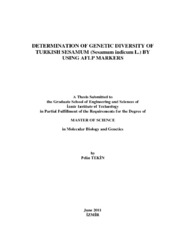Please use this identifier to cite or link to this item:
https://hdl.handle.net/11147/3146Full metadata record
| DC Field | Value | Language |
|---|---|---|
| dc.contributor.advisor | Doğanlar, Sami | en |
| dc.contributor.author | Tekin, Pelin | - |
| dc.date.accessioned | 2014-07-22T13:50:58Z | - |
| dc.date.available | 2014-07-22T13:50:58Z | - |
| dc.date.issued | 2011 | en |
| dc.identifier.uri | http://hdl.handle.net/11147/3146 | - |
| dc.description | Thesis (Master)--Izmir Institute of Technology, Molecular Biology and Genetics, Izmir, 2011 | en |
| dc.description | Includes bibliographical references (leaves: 32-35) | en |
| dc.description | Text in English; Abstract: Turkish and English | en |
| dc.description | ix, 35 leaves | en |
| dc.description.abstract | Sesame (Sesamum indicum L.) belongs to the Pedaliaceae family. It is an important oil seed crop which is cultivated in tropical and subtropical areas of Asia and Africa. China is the largest producer of sesame seed in the world while Turkey ranks seventh and produces 21036 tonnes of sesame seed in a year. Although sesame's edible seed and high quality seed oil are important for both humans and the economy, there is not enough information about the sesame genome in the literature. Our aim was to determine the diversity of 158 Turkish sesame accessions by using the AFLP marker system and to design a new set of sesame-specific SSR markers from genomic sequence of S. indicum. The Turkish sesame accessions were tested with five AFLP primer combinations, as a result, 148 polymorphic fragments were obtained. The maximum similarity was 57% for the accessions and a good level of diversity was present in the sesame germplasm. Secondly, a genomic library of sesame was constructed. A total of 1.094.317 reads were obtained and 702.371 of them were clustered to 140.669 reads containing 93.365 nucleotides. A total of 3101 primer pairs were developed from flanking regions of SSRs with primers for dinucleotide (36,4%), tetranucleotide (29,3%), trinucleotide (23,1%), pentanucleotide (7,1%), and hexanucleotide (4,2%) repeats. These primers are the first genomic-SSR markers developed for sesame cultivars. SSRs have good reproducibility, high genome coverage, co-dominant inheritance, good transferability to close species and are multiallelic. The designed genomic-SSRs should be very useful for sesame mapping and diversity studies. | en |
| dc.language.iso | en | en_US |
| dc.publisher | Izmir Institute of Technology | en |
| dc.rights | info:eu-repo/semantics/openAccess | en_US |
| dc.subject.lcsh | Sesame--Genetics | en |
| dc.subject.lcsh | Plant genetics | en |
| dc.title | Determination of genetic diversity of Turkish sesamum (Sesamum indicum L.) by using AFLP markers | en_US |
| dc.type | Master Thesis | en_US |
| dc.institutionauthor | Tekin, Pelin | - |
| dc.department | Thesis (Master)--İzmir Institute of Technology, Molecular Biology and Genetics | en_US |
| dc.relation.publicationcategory | Tez | en_US |
| item.grantfulltext | open | - |
| item.openairetype | Master Thesis | - |
| item.languageiso639-1 | en | - |
| item.cerifentitytype | Publications | - |
| item.fulltext | With Fulltext | - |
| item.openairecristype | http://purl.org/coar/resource_type/c_18cf | - |
| Appears in Collections: | Master Degree / Yüksek Lisans Tezleri | |
Files in This Item:
| File | Description | Size | Format | |
|---|---|---|---|---|
| T000956.pdf | MasterThesis | 919.79 kB | Adobe PDF |  View/Open |
CORE Recommender
Page view(s)
122
checked on Jul 15, 2024
Download(s)
46
checked on Jul 15, 2024
Google ScholarTM
Check
Items in GCRIS Repository are protected by copyright, with all rights reserved, unless otherwise indicated.